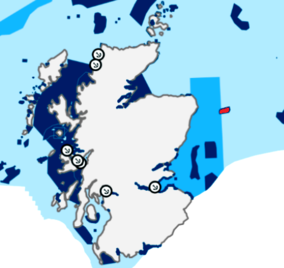| Turbot Bank MPA | |
|---|---|
 The location and extent of the Turbot Bank MPA, shown in red | |
| Location | North Sea, Scotland |
| Coordinates | 57°23′N 0°53′W / 57.383°N 0.883°W |
| Area | 251 km2 (97 sq mi)[1] |
| Designation | Scottish Government |
| Established | 2014 |
| Operator | Marine Scotland |
The Turbot Bank is a shelf bank and mound feature of the seabed of the North Sea that lies off the east coast of Scotland, about 44 kilometres (27 mi) east of Peterhead. The depth of water above the bank varies from 60 m below sea level on top of the bank down to 80 m at its margins.[2] It has been designated as a Nature Conservation Marine Protected Area since 2014.[1]
It is an important habitat for sand eels, small fish of various species that are eaten by seabirds such as Atlantic puffin (Fratercula arctica) and black-legged kittiwake (Rissa tridactyla), as well as fish such as plaice (Pleuronectes platessa) and marine mammals such as dolphins. The bank is particularly associated with Raitt's sand eel (Ammodytes marinus), which live buried in the sand of the bank for months at a time.[2]
See also
[edit]References
[edit]- ^ a b "SiteLink: Turbot Bank MPA(NC)". NatureScot. Retrieved 12 October 2020.
- ^ a b "Turbot Bank MPA". Joint Nature Conservation Committee. Retrieved 28 November 2019.
External links
[edit]- Turbot Bank Site Summary Document – Joint Nature Conservation Committee
Well, that’s interesting to know that Psilotum nudum are known as whisk ferns. Psilotum nudum is the commoner species of the two. While the P. flaccidum is a rare species and is found in the tropical islands. Both the species are usually epiphytic in habit and grow upon tree ferns. These species may also be terrestrial and grow in humus or in the crevices of the rocks.
View the detailed Guide of Psilotum nudum: Detailed Study Of Psilotum Nudum (Whisk Fern), Classification, Anatomy, Reproduction